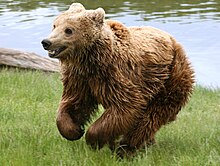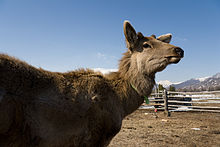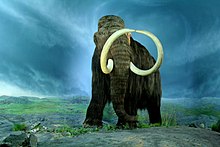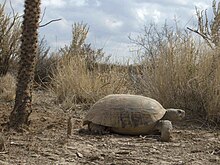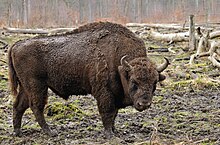| Pleistocene Park | |
|---|---|
| Плейстоценовый парк | |

Depiction of some mammals common in northern Eurasia during the late Pleistocene, by Mauricio Antón. From left to right: wild horse, woolly mammoth, reindeer, cave lion and woolly rhinoceros.
|
|
| Location | Russian Arctic, Sakha Republic |
| Nearest city | Chersky |
| Coordinates | 68°30′48″N 161°31′32″ECoordinates: 68°30′48″N 161°31′32″E |
| Area | 160 km2 (60 sq mi) |
| Established | 1988 / 1996 |
| Founder | Sergey Zimov |
| Director | Nikita Zimov |
| Website | www |
Pleistocene Park (Russian: Плейстоценовый парк) is a nature reserve on the Kolyma River south of Chersky in the Sakha Republic, Russia, in northeastern Siberia, where an attempt is being made to recreate the northern subarctic steppe grassland ecosystem that flourished in the area during the last glacial period.
The project is being led by Russian scientist Sergey Zimov,[3] with hopes to back the hypothesis that overhunting, and not climate change, was primarily responsible for the extinction of wildlife and the disappearance of the grasslands at the end of the Pleistocene epoch.[4][5]
A further aim is to research the climatic effects of the expected changes in the ecosystem. Here the hypothesis is that the change from tundra to grassland will result in a raised ratio of energy emission to energy absorption of the area, leading to less thawing of permafrost and thereby less emission of greenhouse gases.[4][5] It is also thought that removal of snow by large herbivores will further reduce the permafrost's insulation.
To study this, large herbivores have been released, and their effect on the local fauna is being monitored. Preliminary results point at the ecologically low-grade tundra biome being converted into a productive grassland biome, and at the energy emission of the area being raised.[6]
A documentary is being produced about the park by an American journalist and filmmaker.[7][8]
Goals
Researching the effects of large herbivores on the arctic tundra/grasslands ecosystem
The primary aim of Pleistocene Park is to recreate the mammoth steppe (ancient taiga/tundra grasslands that were widespread in the region during the last ice age). The key concept is that animals, rather than climate, maintained that ecosystem. Reintroducing large herbivores to Siberia would then initiate a positive feedback loop promoting the reestablishment of grassland ecosystems. This argument is the basis for rewilding Pleistocene Park's landscape with megafauna that were previously abundant in the area, as evidenced by the fossil record.[4][5][9]The grassland-steppe ecosystem that dominated Siberia during the Pleistocene disappeared 10,000 years ago and was replaced by a mossy and forested tundra and taiga ecosystem.[4] Concurrently, most of the large herbivores that roamed Siberia during the Pleistocene have vanished from the region.[5] The mainstream explanation for this used to be that at the beginning of the Holocene the arid steppe climate changed into a humid one, and when the steppe vanished so did the steppe's animals.[4] Sergei Zimov points out that in contradiction to this scenario:
- Similar climatic shifts occurred in previous interglacial periods without causing such massive environmental changes,[4][5][9]
- Those large herbivores of the former steppe that survived until today (e.g. musk oxen, bison, horses) thrive in humid environments just as well as in arid ones,[4][5][9]
- The climate (both temperatures and humidity) in today's northern Siberia is in fact similar to that of the mammoth steppe. The radiation aridity index for northern Siberia on Mikhail Budyko's scale is 2 (= steppe bordering on semi-desert).[4][5][9] Budyko's scale compares the ratio of the energy received by the earth's surface to the energy required for the evaporation of the total annual precipitation. The 'humid climate' argument was based on other scales, which compare precipitation to potential evapotranspiration. Moss has a very low transpiration rate and thus causes humidity without necessarily needing humidity for its establishment. Using these other scales as a proof for humidity being the cause of the disappearance of the grasslands therefore constitutes a circular argument, which is not scientifically viable.
Researching the effects of large herbivores on permafrost and global warming
A secondary aim is to research the climatic effects of the expected changes in the ecosystem. Here the key concept is that some of the effects of the large herbivores, such as eradicating trees and shrubs or trampling snow, will result in a stronger cooling of the ground in the winter, leading to less thawing of permafrost during summer and thereby less emission of greenhouse gases.Permafrost is a large global carbon reservoir that has remained frozen throughout much of the Holocene.[12] Due to recent climate change, the permafrost is beginning to thaw, releasing stored carbon and forming thermokarst lakes.[12][13] When the thawed permafrost enters the thermokarst lakes, its carbon is converted into carbon dioxide and methane and released into the atmosphere. Methane is a potent greenhouse gas and the methane emissions from thermokarst lakes have the potential to initiate a positive feedback cycle in which increased atmospheric methane concentrations lead to amplified global climate change, which in turn leads to more permafrost thaw and more methane and carbon dioxide emissions.[15][16]
As the combined carbon stored in the world's permafrost (1670 Gt)[17] equals about two times the amount of the carbon currently released in the atmosphere (720 Gt),[18] the setting in motion of such a positive feedback cycle could potentially lead to runaway climate change scenario. Even if the ecological situation of the arctic were as it was 400,000 years ago (i.e., grasslands instead of tundra), a global temperature rise of 1.5 °C (2.7 °F) relative to the pre-industrial level would be enough to start the thawing of permafrost in Siberia.[19] An increased cooling of the ground during winter would raise the current tipping point, potentially delaying such a scenario.
Implementation
Background: regional Pleistocene ecoregions
It has been proposed that the introduction of a variety of large herbivores will recreate their ancient ecological niches in Siberia and regenerate the Pleistocene terrain with its different ecological habitats such as taiga, tundra, steppe and alpine terrain.The main object, however, is to recreate the extensive grasslands that covered the Beringia region in the late Pleistocene. This form of grassland (also known as mammoth steppe) was inhabited by a diverse set of large and medium herbivores. Back in the Pleistocene the area was populated by many species of grazers that assembled in large herds similar in size to those in Africa today. Species that roamed the great grasslands included the woolly mammoth, woolly rhino, steppe wisent, Lena horse, muskox, and reindeer.
Another herbivore that was abundant in this region during the Pleistocene but now faces possible extinction in its remaining habitats is the saiga antelope, which can form massive herds that keep the vegetation down.
At the edges of these large stretches of grassland could be found more shrub-like terrain and dry conifer forests (similar to taiga). In this terrain the browsers of the Pleistocene were to be found. This group of megafauna included woolly rhinoceros, moose, wapiti, Yukon wild ass, and camels. The more mountainous terrain was occupied by several species of mountain-going animals like the snow sheep.
Back in the Pleistocene there was also a great variety of carnivorous mammals as well. On the plains there were prides of Beringian cave lion. These large cats were the apex predators of the region, but also shared their habitat with other predators such as grey wolf, cave hyena, Homotherium, brown bear, wolverine, and Arctic fox, which all occupied a distinct ecological niche essential for the balance of their respective ecosystems.
On the edges of the grasslands (in the shrubs and forests) there were also brown bears, wolverines, cave bears, lynxes, tigers, leopards, and red foxes. The Siberian tiger and Amur leopard occupied the southern part of the steppe biome and surviving populations are still found along the present Russian-Sino border in the Amur and Primorye regions.
Proposed procedure
In present-day Siberia only a few of the former species of megafauna are left, and their population density is extremely low, too low to affect the environment. To reach the desired effects, the density has to be raised artificially by fencing in and concentrating the existing large herbivores. A large variety of species is important as each species affects the environment differently and as the overall stability of the ecosystem increases with the variety of species[4] (compare Biodiversity#Biodiversity and ecological services). Their numbers will be raised by reintroducing species that went locally extinct (e.g., muskoxen). For species that went completely extinct, suitable replacements will be introduced if possible (e.g., wild Bactrian camels for the extinct Pleistocene camels of the genus Paracamelus). As the number of herbivores increases, the enclosure will be expanded.While this is taking place, the effects will be monitored. This concerns for example the effects on the flora (are the mosses being replaced by grasses, etc.), the effects on the atmosphere (changes in levels of methane, carbon dioxide, water vapor) and the effects on the permafrost.
Finally, once a high density of herbivores over a vast area has been reached, predators larger than the wolves will have to be introduced to keep the megafauna in check.[4][5]
Progress and plans
- 1988–1996
- 1996–2004
Restored grasslands in Pleistocene Park
The vegetation in the park started to change. In the areas where the horses grazed, the soil has been compacted[23] and mosses, weeds and willow shrub were replaced by grasses.[3][6][21][31] Flat grassland is now the dominating landscape inside the park.[30] The permafrost was also influenced by the grazers. When air temperature sank to –40 °C (–40 °F) in winter, the temperature of the ground was found to be only –5 °C (+23 °F) under an intact cover of snow, but –30 °C (–22 °F) where the animals had trampled down the snow. The grazers thus help keep permafrost intact, thereby lessening the amount of methane released by the tundra.[6][9]
- 2004–2011
The new enclosure finally allowed a more rapid development of the project.[21] After the fence was completed, reindeer were brought into the park from herds in the region and are now the most numerous ungulates in the park.[27][33] To increase moose density in the park, special constructions were added to the fence in several places that allow animals outside the fenced area to enter the park, while not allowing them to leave. Besides that, wild moose calves were caught in other regions and transported to the park.[34]
In 2007 a 32-meter (105-foot) high tower was erected in the park that constantly monitors the levels of methane, carbon dioxide and water vapor in the park's atmosphere.[22][35]
In September 2010 the muskox was reintroduced. Six male animals were imported from Wrangel Island,[36] two of which died in the first months.[22][37] Seven months later, in April 2011, six Altai wapitis and five wisents arrived at the park, the wapitis originating from the Altai mountains and the wisents from Prioksko-Terrasny Nature Reserve near Moscow.[38][39] But the enclosing fence proved too low for the wapitis, and by the end of 2012 all six wapitis had jumped the fence and run off.[11]
- 2011–2016
- 2017–
For the near future the focus in animal introductions will generally be placed on browsers, not grazers, i.e., bison, muskoxen, moose and wapiti. Their role in this phase will be to diminish the amount of shrubs and trees and enlarge the grassy areas. Only when these areas have sufficiently increased will grazers like saiga and kiang be introduced.[54][55]
Reception
Controversial aspects
Critics admonish that introducing alien species could damage the fragile ecosystem of the existing tundra. To this criticism Sergey Zimov replied: ″Tundra – that is not an ecosystem. Such systems had not existed on the planet [before the disappearance of the megafauna], and there is nothing to cherish in the tundra. Of course, it would be silly to create a desert instead of the tundra, but if the same site would evolve into a steppe, then it certainly would improve the environment. If deer, foxes, bovines were more abundant, nature would only benefit from this. And people too. However, the danger still exists, of course, you have to be very careful. If it is a revival of the steppes, then, for example, small animals are really dangerous to release without control. As for large herbivores – no danger, as they are very easy to remove again.″[56]Another point of concern is doubt that the majority of species can be introduced in such harsh conditions. For example, according to some critics, the Yakutian horses, although they have been living in the park for several generations, would not have survived without human intervention. They normally tolerate –60 °C, but are said to cope poorly with an abundance of snow and possibly would have died within the first snowy winter of starvation. However, horses of much less primitive stock abandoned by the Japanese Army have been living feral on some uninhabited Kuril Islands since 1945. Despite the deep snows (two to three times deeper than in Yakutia), they have successfully survived all the winters without feeding. And in Pleistocene Park, while some of the Yakutian horses accept supplementary feeding, others keep away and survive on their own.[22]
Positive reception
The Zimov’s concept of Pleistocene Park and repopulating the mammoth steppe is listed as one of the “100 most substantive solutions to global warming” by Project Drawdown.[57] The list, encompassing only technologically viable, existing solutions, was compiled by a team of over 200 scholars, scientists, policymakers, business leaders and activists;[58][59] for each solution the carbon impact through the year 2050, the total and net cost to society, and the total lifetime savings were measured and modelled.[60][61]Visitors
The park is a hub for international scientists and students, who come from around the world to conduct their own ecological research and experiments.[6] The Polaris Project was a yearly visitor from 2009 to 2015, sending US-American students on excursions to the park each summer.[62]Another group of visitors are journalists. The park is steadily gaining more media attention and while most journalists do not come to the park itself the number of visitors is increasing. In 2016 for example, the park was visited by a filmmaker, two print media (Swiss 24 Heures and American The Atlantic), and two TV broadcasting companies (German ARD and American HBO).[63]
The total of visitors for 2016 (summer months only) was 45.[64]
Size and administration
Pleistocene Park is a 160 km2 scientific nature reserve (zakaznik) consisting of willow brush, grasslands, swamps, forests and a multitude of lakes.[4][65][note 2] The average temperature in January is about –33 °C and in July +12 °C; annual precipitation is 200–250 mm.[5]Pleistocene Park is owned and administered by a non-profit corporation, the Pleistocene Park Association, consisting of the ecologists from the Northeast Science Station in Chersky and the Grassland Institute in Yakutsk.[65] The present park area was signed over to the association by the state and is exempt from land tax.[66] The reserve is surrounded by a 600 km2 buffer zone that will be added to the park by the regional government once the animals have successfully established themselves.[65]
In July 2015 the Pleistocene Park Foundation was founded, a non-profit organization (registered in Pennsylvania, USA, with 501(c)(3) status)[67] dedicated to acquiring private donations for funding Pleistocene Park.[68] Hitherto Pleistocene Park had been financed solely through the funds of the founders, a practice that grew increasingly insufficient.[68]
Animals
Animals already present in the park:Herbivores:
- Reindeer (Rangifer tarandus):[33] Present before the project started (although more are being brought to help simulate Pleistocene conditions). They mainly graze in the southern highlands of the park. This territory is not affected by spring flooding and dominated by larch forests and shrubland. Reindeer rarely visit the flood plain. Besides actively grazing (especially in winter) they browse on willow shrubs, tree moss, and lichens. (Numbers in park in July 2017: approximately 20)[69]
- Elk[BE]/moose[AE] (Alces alces):[34] Present before the project started, although in low numbers. Immigration from neighboring areas is stimulated. Due to poaching the density of moose in the region has substantially decreased in the last 20 years. To increase moose density in the park, special constructions were added to the fence in several places that allow animals outside the fenced area to enter the park, while not allowing them to leave. Besides that wild moose calves are being caught in other regions and transported to the park.[34] It is the largest extant species of the deer family and one of the largest herbivores in the park today. (Numbers in park in July 2017: approximately 15)[69]
- Yakutian horse (a domestic breed of Equus ferus caballus):[70] The first species to be introduced for the project, they were imported from the surrounding Srednekolymsk region beginning in 1988.[70] Yakutian horses have developed a range of remarkable morphologic, metabolic and physiologic adaptions to the harsh environment of Siberia, including an extremely dense and long winter coat, a compact build, a metabolism adjusted to seasonal needs, and an increased production of antifreezing compounds.[71][72] In summer they grow very large hooves, which they wear down in winter scraping away snow to get at food. Despite their size, they proved to be dominant over the wisents, who often fled from them. Yakutian horses are purely grazing animals – they eat only grass species, and visit the park's forests only during the spring flood. In the spring of 2015, ten more Yakutian horses were acquired to increase genetic diversity.[73] (Numbers in park in May 2018: approximately 30)[66]
Muskoxen family
- Muskox (Ovibos moschatus):[74] Muskoxen arrived at the park in September 2010. They were brought from Wrangel Island[74] (itself repopulated with animals from North America). They are doing well and are now fully grown. Unfortunately only males could be acquired, and the Zimovs are now urgently looking for females.[37] The introduction of more muskoxen is planned for 2019.[53] (Numbers in park in July 2017: 3 males)[69]
- Wisent (European bison, Bison bonasus):[75] During the last ice age, wisents were the most cold-adapted of the Bison species and thrived in the glacial grassland-steppe biome.[76][note 3] Their dietary needs are very different from the American bison. Year-round 10% of their intake necessarily consists of trees and shrubs, and they will ignore their main forage (grasses, sedges and forbs) in favour of woody forage to reach this quota.[77] Without supplementary feeding in winter, the yearly average may rise to 20% even in countries with mild winters.[78] Five wisents, one adult male and four juvenile females, were introduced in the park in April 2011. The wisents were brought to the park from the Prioksko-Terrasny Nature Reserve near Moscow.[39][75] The transportation was more complicated and took a longer time than originally thought, but all the animals recovered rapidly after the trip. Unfortunately, the wisents did not sufficiently acclimatize in the first months. They started to moult in November, when temperatures already were down to –30 °C (–35 °F) in Cherskii. The four juveniles died; only the adult bull survived. He is now fully acclimatized.[26][79] (Numbers in park in July 2017: 1 male)[69]
Domestic yak in the Altai Mountains
- Domestic yak (Bos mutus grunniens): Ten domestic yaks acquired in Irkutsk Oblast were introduced in Pleistocene Park in June 2017; two calves were born a few days after the arrival.[47] Yaks are adapted to extreme cold, short growing seasons for grazing herbage, and rough grazing conditions with sedges and shrubby plants. Wild yaks once lived in western Beringia.[citation needed] (Numbers in park in June 2017: 10 adults, 2 calves)[47][48]
- Edilbaevskaya sheep (a domestic breed of Ovis orientalis aries):[80] 30 domestic sheep acquired in Irkutsk Oblast were introduced in Pleistocene Park in October 2017.[49][50] The sheep are from a breed that is adapted to the Siberian cold.[49] They belong to the breed group of fat-tailed sheep; their fatty rump evolved to store fat as a reserve for lean seasons,[81] similar to a camel’s humps.[82] (Numbers in park in May 2018: approximately 35)[66]
- Non-ungulate herbivores to be found in the park are the snow hare (Lepus timidus), the black-capped marmot (Marmota camtschatica), and the Arctic ground squirrel (Spermophilus parryii),[4][5] as also the muskrat (Ondatra zibethicus) and diverse species of voles.[83]
- Eurasian lynx (Lynx lynx): Present before the project started.[4] It is an important predator of medium-sized herbivores like hares and roe deer.
- Tundra wolf (Canis lupus albus): Despite the original low concentration of ungulates, the area was home to a wolf family already[84] before the project started.[4] This arctic subspecies of the grey wolf is widespread from northern Scandinavia to the Kamchatka Peninsula.
- Arctic fox (Vulpes lagopus): Present before the project started.[4] Well adapted to living in the arctic environment, its fur changes color with the season: white in winter, brown in summer.
- Eurasian brown bear (Ursus arctos arctos): Present before the project started.[4][5] Currently the largest predator in the region.
- Wolverine (Gulo gulo): Present before the project started.[4][5] A stocky and muscular carnivore, the wolverine is a powerful and versatile predator and scavenger.
- Red fox (Vulpes vulpes): Present before the project started.[4] Red foxes are omnivores with a highly varied diet. In the former Soviet Union, up to 300 animals and a few dozen plant species are known to be consumed by them.
- Sable (Martes zibellina): Present before the project started.[83]
- Stoat (Mustela erminea): Present before the project started.[83]
Herbivores:
- American bison (Bison bison):
- Plains bison (Bison bison bison): Twelve yearling plains bison, nine males and three females,[85] have been acquired and will be introduced in the park once the United States’ FAA gives clearance for the flight.[86][87] The plains bison were bought from the Stevens Village Bison Reserve[note 4] near Delta Junction in Alaska; as the climate there is comparable to that of Siberia, the young bison are expected to thrive.[91] Plains bison are grazers of grasses and sedges. Unlike wisents, plains bison are almost pure grazers, which will consume other plant material mainly in time of need.[92][93][94] While wood bison were the preferred choice of subspecies, they are not easy to acquire;[79][95] plains bison simply are the subspecies that could be brought to the Park most easily.[45][96] (Numbers being introduced as of June 2018: 9 males, 3 females)[85]
- Wood bison (Bison bison athabascae): Better adapted to life in the Far North than the plains bison.[45] Mainly a grazer of grasses and sedges,[92][97] seasonally supplements this diet with other plant material like forbs, lichen, and silverberry and willow leaves.[97][98] Wet meadows in bottomlands (like the Kolyma river plain) are an important habitat for wood bison.[97] The original plans for the rewilding of Bison had called for the introduction of wood bison as an ecological proxy for the extinct steppe wisent, Bison priscus.[84][99] These plans did not work out[100][101] and wisents were acquired instead.
- Altai wapiti or Altai maral (Cervus canadensis sibiricus): Had been introduced in April 2011.[102] The wapiti made their way to the park all the way from the mountainous regions of Altai in central southern Siberia.[102] Wapiti are very good jumpers and all six escaped within the first two years. The fence has been strengthened to cope with future introductions.[11][41]
- Wild yak (Bos mutus): Could be brought from the Tibetan Plateau. Along with the bison, horse, and reindeer, the species could contribute to the further proliferation of grasses in the region.[11][103]
- Snow sheep (Ovis nivicola): Immigration from neighboring areas is encouraged. Especially rams may be lured to the park by domestic ewes in rut.[citation needed]
- Saiga antelope (Saiga tatarica): Introduction is in the planning stage. Its presence would be critical for the regulation of poisonous plants in the region that can be digested by the saiga but are harmful to other herbivores. Currently, free saigas can only be found in Russia in the Chyornye Zemli Nature Reserve.
- Wild Bactrian camel (Camelus ferus) or Bactrian camel (Camelus bactrianus): Either of the two-humped camel species could act as a proxy for extinct Pleistocene camel species, whose fossils have been found in areas that once formed part of Beringia.[103] The camel evolved in the high arctic as a large boreal browser; its hump presumably evolved to store fat as a resource for the long winter.[82] Bactrian camels will eat almost anything, preferably any plant material such as grass, shrubs, bark, etc., but in times of need also carrion.[104][105] In the winter they will dig under snow to get at forage.[104] The wild Bactrian camel is critically endangered and is only found in some few areas of China and Mongolia.
- Siberian roe deer (Capreolus pygargus): Immigration from neighboring areas is encouraged.
- Siberian tiger (Panthera tigris altaica): Introduction planned for a later stage, when herbivores have multiplied.[4][5][22] Endangered and reduced to the Primorye region. As the largest feline alive, the Siberian tiger could play a key role in regulating the numbers of the largest herbivores.
- Woolly mammoth (Mammuthus primigenius): In January 2011, the Yomiuri Shimbun reported that a team of scientists from Kyoto University were planning to extract DNA from a mammoth carcass preserved in a Russian laboratory and insert it into egg cells of elephants in hope of creating a mammoth embryo. If the experiment succeeded, the calf would be taken to the park along with others to form a wild population. The researchers claimed that their aim was to produce the first mammoth within six years.[103][106][107][108][109]
Southern branch of Pleistocene Park: The Wild Field wilderness reserve
In 2012 to 2014 a branch of Pleistocene Park named ″Wild Field″ (Russian: Дикое поле Dikoe pole) was constructed near the city of Tula in Tula Oblast in the European part of Russia, approximately 250 km (150 mi) south of Moscow.[26][110]Unlike Pleistocene Park, Wild Field's primary purpose is not scientific research but public outreach, i.e., it will provide a model of what an unregulated steppe ecosystem looked like before the advent of humans. It is situated near a federal road and a railway station and will be accessible to the general public.[110]
Wild Field comprises 300 ha (740 ac)[110] of which 280 ha have been fenced off and stocked with animals.[111] Already present in the park are nine species of large herbivores and one omnivore species: Bashkir horses (a strain of Equus ferus caballus) from the southern part of the Ural Mountains,[112][113] Altai maral/Altai wapiti (Cervus canadensis sibiricus),[113] Edilbaevskaya sheep (a strain of Ovis orientalis aries),[114] roe deer (Capreolus spec.),[note 5][110][116] Kalmykian cattle (a strain of Bos primigenius taurus),[117][118] domestic yaks (Bos mutus grunniens),[117][118][119] wild boar (Sus scrofa),[119] one female elk[BE]/moose[AE] (Alces alces),[119] four reindeer (Rangifer tarandus)[120] and 73 domestic Pridonskaya goats (a strain of Capra aegagrus hircus).






